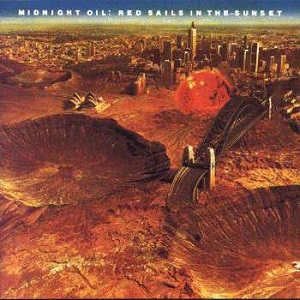Red Sails in the Sunset (album)
| Red Sails in the Sunset | ||||
|---|---|---|---|---|
 |
||||
| Studio album by Midnight Oil | ||||
| Released | October 1984 | |||
| Recorded | June–August 1984 Victor Aoyama Studio, Tokyo, Japan |
|||
| Genre | Post-punk, rock, new wave | |||
| Length | 50:33 | |||
| Label | Sprint, Columbia | |||
| Producer | Nick Launay, Midnight Oil | |||
| Midnight Oil chronology | ||||
|
||||
| Singles from Red Sails in the Sunset | ||||
|
||||
| Professional ratings | |
|---|---|
| Review scores | |
| Source | Rating |
| AllMusic | |
| Rolling Stone | (favourable) |
| Spin | (favourable) |
Red Sails in the Sunset is a rock album by Australian group Midnight Oil which was released in October 1984 under the Columbia Records label. It was recorded and produced in Tokyo, Japan and is significant for becoming their first No. 1 album in Australia – it also entered the United States Billboard 200. The cover image, by Japanese artist Tsunehisa Kimura, depicts Sydney Harbour after a hypothetical nuclear strike. Some of its tracks were performed live in January 1985 at a Sydney Harbour Goat Island concert to celebrate radio station Triple J's 10th birthday, which was simulcast on ABC Television and subsequently re-broadcast on their then-Tuesday night music program Rock Arena. In 2004 the film footage later became part of a DVD album, Best of Both Worlds. Red Sails in the Sunset contains the only Midnight Oil tracks with lead vocals provided by their drummer Rob Hirst, "When the Generals Talk" and "Kosciusko". The album spawned two singles, "When the Generals Talk" and "Best of Both Worlds" but neither appeared on the Australian singles chart.
Midnight Oil released Red Sails in the Sunset in October 1984. It was recorded in June to August in Japan, and was produced by Nick Launay, who had worked on their breakthrough album, 10, 9, 8, 7, 6, 5, 4, 3, 2, 1 (1982). Columbia asked the band to return to the studio and record a more commercial single that could chart in America, but the band refused. Drummer Rob Hirst said that the band told Columbia to take it or leave it, and Columbia released the album as-is. It peaked at No. 1 for four weeks on the Australian charts, and charted on the Billboard 200. Singles from the album were also released in the United States and United Kingdom but had no chart success. Whilst the album showed an over-reliance on technical wizardry, their lyrical stance was positive. The band continued to expand their sound and explore themes of politics, consumerism, militarism, the threat of nuclear war and environmental issues.
...
Wikipedia
